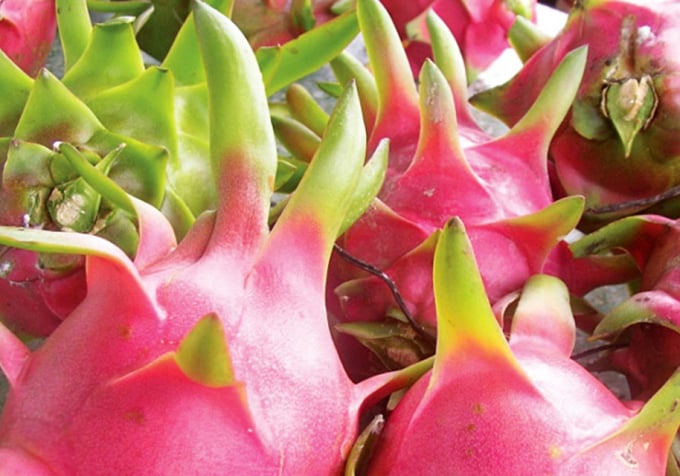May 18, 2025 | 18:25 GMT +7
May 18, 2025 | 18:25 GMT +7
Hotline: 0913.378.918
May 18, 2025 | 18:25 GMT +7
Hotline: 0913.378.918

Dragon fruits as well as other types of fruits in Vietnam are suitable for the Iran market. Photo: TL.
In search of potential export markets for agro-product businesses in the country, the Department of Trade Promotion (Ministry of Industry and Trade) has recently opened an export consultation session to the Iran market. Ms. Nguyen Thu Thuy, Deputy Director of the Export Promotion Center (Promocen), said, “With a population of approximately 86 million people, the Iran market holds a large consumption volume when compared to other countries in the Middle East.”
The trade turnover between Vietnam and Iran has stood still at just over USD 100 million for several years. This is a very modest figure considering the Iran market’s potential for consumption of many strong agro-products of Vietnam.
In the structure of goods, Vietnam exports to Iran mainly agricultural and fishery products such as pepper, cashew nuts, tea, coffee, natural rubber products, vegetables, fruits, handicrafts, wooden products and a wide variety of seafood.
According to Mr. Nguyen Thanh Long, Vietnam Trade Office in Iran, Vietnamese and Iranian agro-products held great complementary effects and did not have much competition within the same product category.
“Iran's high import demand for agricultural products is largely due to frequent droughts and crop failures. Meanwhile Vietnamese products have certain popularity in Iran because the quality is guaranteed. The majority of Iranians say they felt a deep connection with Vietnam as both countries once suffered from USA sanctions. This is also an advantage for Vietnamese agro-products to penetrate this market.”
Among the mentioned products, Vietnam mainly focuses on a number of key goods when exporting to Iran such as tea, pepper, cashew nuts, coffee, vegetables and fish fillets.
Cashew nuts, pepper, coffee and tea account for most of the agricultural product export turnover to Iran. In 2021 Vietnam exported to Iran USD 30 million of cashew nuts, USD 17 million of coffee, USD 14 million of pepper, and USD 7 million of tea.
Ms. Nguyen Thi Hien Giang, Director of Lam Thanh Hung Trading Co., Ltd., shared that Iranians loved to eat fruit. The average consumption rate was 120 kg/person/year.
Every year Iran imports 470 thousand tons of tropical fruits which is equivalent to USD 700 million. The main imported tropical fruits are bananas, coconuts and mangoes due to low or zero domestic production capability. Berries are also a favorite among Iranians.
“If we do good marketing, we can even export dragon fruit, passion fruit, guava, papaya, mangosteen and pomelo to Iran,” said Ms. Giang.
One thing to note is that the import demand for dragon fruits remains strong in foreign markets. Vietnam is still holding well as a major dragon fruit supplier for China in 2021 while suffering a sharp decrease in fruit export volume due to limited customs clearance capacity. Latest information from Produce Report shows that Vietnamese dragon fruit is being sold for 12 Chinese yuan at the Jiangnan fruit market in Guangzhou city, equivalent to about VND 43,000/kg, and the number is still growing strong.
Translated by Samuel Pham

(VAN) In the face of counterfeit and imitation products, Khanh Hoa Salanganes Nest Company hopes for the prompt completion of the legal framework, strict enforcement against violations, and protection of the bird’s nest brand.

(VAN) Japan's efforts to lower the price of rice through the release of its stockpile may finally be making some progress, albeit at a snail's pace.

(VAN) U.S. tariffs are not only a 'shock', but also an opportunity for Vietnamese businesses to renew their mindset toward comprehensive development.

(VAN) As Bac Giang lychee enters the harvest season, Minister Do Duc Duy expects that the fruit will contribute greatly to agricultural exports due to standardized production and deep processing.

(VAN) Consumers have shown a preference for free-range eggs, but those farming systems are more vulnerable to biosecurity risks like bird flu.
/2025/05/09/5701-1-184335_301.jpg)
(VAN) Vietnam’s eel exports nearly doubled thanks to a mud-free farming model, opening up new prospects while still facing numerous barriers related to international standards.

(VAN) Minister Do Duc Duy warned that if production is not professionalized and supply chains are not transparent, the U.S. market could become a growth bottleneck.